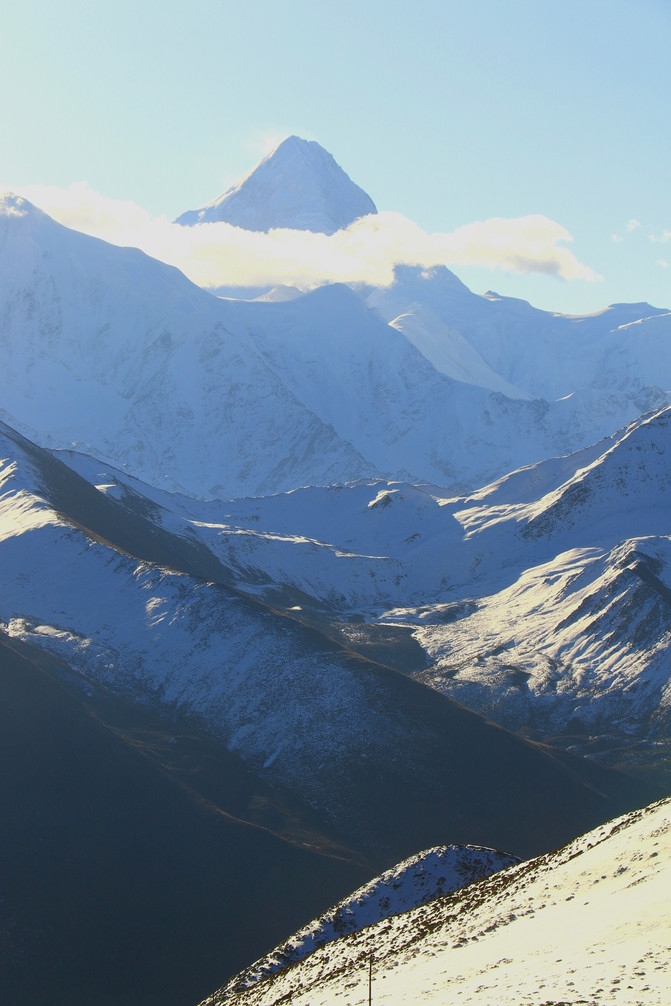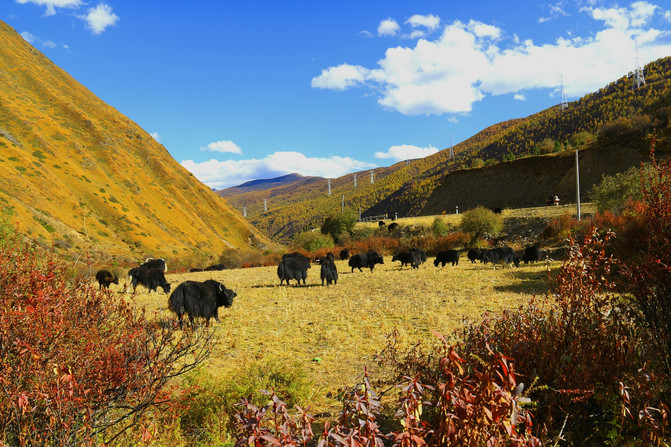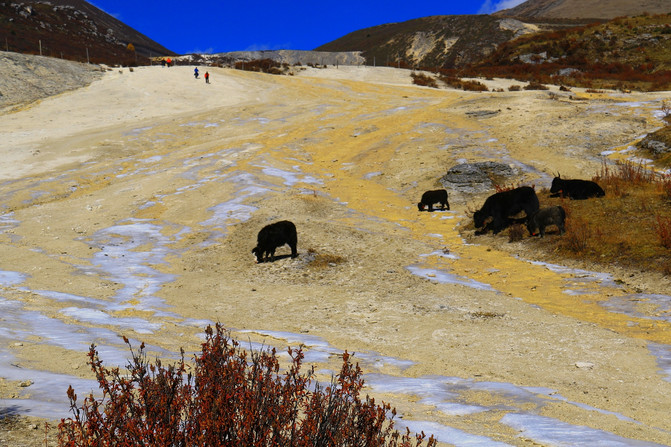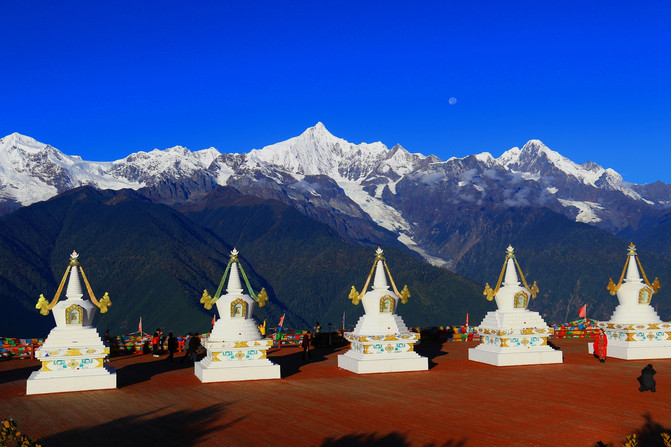Tips for self-driving tours in Western Yunnan and Western Sichuan in October 2019 (6) Conclusion
Yunnan-Deqin-Benzilan-Jinsha River Bay

Sichuan-Daocheng-Daocheng Yading Scenic Area-Milk Sea

Yunnan-Deqin-Feilai Temple-Meili Snow Mountain-Rizhao Jinshan

Sichuan-Daocheng-Hongcaotan

Sichuan-Dege-Xinluhai

Sichuan-Xinlong-Coka Lake

Sichuan-Kangding-Quanhuatan

Xizang-Mangkang-Millennium Ancient Salt Field

A self-driving tour in western Yunnan and western Sichuan in the golden autumn of October takes a total of 30 days from October 5 to November 3, with a journey of 8550 kilometers. The scenery along the way is picturesque and beautiful. I enjoyed the colorful autumn colors, enjoyed the unique scenery of "Three Rivers Parallel Flowing", appreciated the folk customs of the Northwest region, and witnessed the rapid development of tourism.
This self-driving tour can be summarized as follows:
The first is to use multiple lines and take many non-highways. From entering Gaoligong Mountain Natural Park on October 9 to arriving in Kangding on October 29, we traveled nearly 4000 kilometers of national highways, provincial highways, county roads and rural trails in these 21 days. Beautiful scenery is on the road, and there are countless scenic spots visited along the way. In western Yunnan, especially western Sichuan, there are too many undeveloped and pristine scenic spots that are not scenic spots. The biggest advantage of self-driving tour is that you can stop anytime and anywhere to enjoy these beautiful scenery. Moreover, many of the scenery along the way that is free of charge are actually very beautiful, which is a feast for the eyes and saves a lot of ticket money.
Sichuan-Daocheng-Daocheng Yading Scenic Area

Sichuan-Daocheng-Daocheng Yading Scenic Area-Chonggu Meadow

Sichuan-Kangding-Xindu Bridge

Sichuan-Kangding-Yahayakou Observation Deck-Gongga Mountain

Sichuan-Kangding-Quanhuatan

Yunnan-Gongshan-Dulongjiang-Scenery along the way

Second, they spend a long time in high-altitude areas. From October 15, the "Degong Highway" from Gongshan in Yunnan to Deqin in Sichuan passed through the Kongque Mountain Pass at an altitude of 3882 meters and began to enter high-altitude areas. By October 30, I left Kangding and spent 16 days walking, sightseeing and living in high-altitude areas. Among them: nearly 10 high mountain passes above 4000 meters; lived at an altitude of about 4000 meters for 4 nights; and continuously climbed on the plateau at an altitude of 3900 meters to 4700 meters for more than 4 hours.
Sichuan-Daocheng-Daocheng Yading Scenic Area-Shanuo Duoji Peak

Sichuan-Daocheng-Daocheng Aden Scenic Area-People climbing the Milk Sea and the Five-Color Sea

Sichuan-Daocheng-Daocheng Yading Scenic Area-Chonggu Meadow

Sichuan-Xinlong-Coka Lake

Sichuan-Kangding-Quanhuatan

Sichuan-Kangding-Quanhuatan

Third, we mainly visit areas inhabited by ethnic minorities. Nu, Lisu, Dulong, etc. in Nujiang Prefecture, western Yunnan; Naxi, Tibetans, etc. in Diqing Prefecture, northwest Sichuan; Tibetans in Ganzi Prefecture, western Sichuan, etc. These ethnic minorities have rich and colorful traditional culture and folk customs, and their houses and buildings are also full of ethnic characteristics. In Dulong Township, I visited the tattooed faced girl unique to the Dulong ethnic group; visited the red wooden shed of the monk's house in Serda; and visited the Changqingchun Kerr Temple in Litang. Especially in the Tibetan areas of Ganzi Prefecture, Tibetan Buddhist temples can be seen everywhere, some of which are large-scale and some are resplendent; prayer flags flying in the air and prayer cylinders that keep rotating; and the prayers of monks chanting, forming another landscape. All of these are worth knowing and watching.
Sichuan-Ganzi-Scenery along the way

Sichuan-Ganzi-Scenery along the way

Sichuan-Ganzi-Scenery along the way

Sichuan-Ganzi-Scenery along the way

Fourth, the temperature difference is particularly large. The large temperature difference is a major feature on the plateau. It is common for the temperature difference within a day at this stage to range from a few degrees below zero to a dozen or twenty degrees above zero. In early October, the temperature from my hometown is nearly 30 degrees, and the coldest in Seda is minus 7 degrees, with a temperature difference of more than 30 degrees. In just one short month, it feels like spring, summer, autumn and winter, so you must bring enough clothes all year round.
The following is the personal experience of this long-distance trip, and we will share some feelings with you from many aspects that self-driving tourists are generally concerned about, such as traffic conditions, seasonal climate, scenic spots, accommodation and diet, altitude sickness, etc.
Sichuan-Kangding-Zimeiyakou Observation Deck-Gongga Mountain

Sichuan-Seda-Scenery along the way

Sichuan-Seda-Scenery along the way

Sichuan-Ganzi-Fengxue Road Section-Scenery along the way

Sichuan-Daocheng-Dianchuan New Tourism Channel-Scenery along the way

(1) Traffic conditions
It should be said that the current highway transportation network extends in all directions, making self-driving travel really convenient. More than 4000 kilometers from Shantou to Baoshan and Kangding to Shantou are all highways. In Nujiang Prefecture in western Yunnan, Diqing Prefecture in northwest Yunnan and Ganzi Prefecture in western Sichuan, although many places are remote areas, the road network is criss-crossed and easy to drive. After walking nearly 4000 kilometers of national highways, provincial highways, county roads and rural trails, most of which are in good condition.
This time, we were fortunate enough to take several roads that had just been opened or newly built. Not only did we have good road conditions and close distances, saving a lot of time, but we also had a panoramic view of the beautiful scenery along the road, killing two birds with one stone. These include: 1. The "Lugong Highway" from Liuku Town, Lushui to Bingzhongluo in Gongshan. The entire line will only be opened during the National Day this year. Although the supporting finishes of several tunnels and roads have not yet been completed, walking is very smooth;2."Dulong River Highway". The 6.68-kilometer-long "Gaoligongshan Dulongjiang Tunnel" was completed in May of the previous year, and the entire line was fully repaired only recently;3. The "Degong Highway" from Gongshan, Yunnan to Deqin, Sichuan. A highway that was said to have taken nearly 10 years of construction and opened in May this year;4. The "New Dianchuan Tourism Corridor" from Benzilan, Yunnan to Daocheng, Sichuan. The new highway was opened to traffic only last year;5. The Ganzi to Seda Highway is also a new road that has been opened not long ago.
Of course, it is only relatively speaking that the road conditions are generally good. Whether it is a new road or an old road, most of them will encounter roads, but there is only a difference between more and less, long and short. This is caused by the special and complex geographical structure of this area, and natural disasters such as landslides and landslides often occur in mountains. Therefore, the good and bad road conditions are dynamic. Today this place is repaired, tomorrow another place may be broken again, and so on.
In general, when traveling by car nowadays, road traffic is no problem and refueling is convenient. However, the traffic conditions of national highways, provincial highways, county roads and rural trails in western Yunnan and western Sichuan are relatively complex. More than half of all the roads traveled on this journey are curved mountain roads, and there are quite a number of falling rock sections. Some sections have a lot of traffic, and some sections have to pass through towns and villages. At the same time, most of these roads have severe speed limits. So be sure to drive carefully for safety. Under normal circumstances, the average speed is 30-50 kilometers per hour, which should be taken into account when making travel arrangements.
Yunnan-Deqin-Yubeng-Meili Snow Mountain-Rizhao Jinshan

Xizang-Mangkang-Millennium Ancient Salt Field

Yunnan-Deqin-Baima Snow Mountain Pass-Baima Snow Mountain

Yunnan-Gongshan-Dulongjiang-Scenery along the way

Sichuan-Daocheng-Dianchuan New Tourism Channel-Scenery along the way

Yunnan-Shangri-La-Balagzong-Shangri-La Grand Canyon

(2) Seasonal climate
In the right season, go to a good place to see the beautiful scenery. Autumn is the most beautiful season in western Sichuan! It is like a color palette overturned by God and gave Ganzi the pure land without reservation. This is beyond doubt. The best time to go to these places to enjoy autumn should be from mid-October to early late October. Early the tree did not turn yellow, but late the leaves fell out again. Of course, the actual time of autumn comes first and later every year, and there will be differences in different places. We specially arranged to visit Daocheng Aden, the main attraction on this trip, around October 20. The time should be correct, but the season will be a little later in the Hongcaotan, especially the 10,000-acre poplar forest. After traveling to so many places along the way, it is impossible to keep every place at a good seasonal time. We can only ensure the key points. In addition, the chance of seeing the beautiful scenery of the Meili Snow Mountain "Rizhao Jinshan" will be higher this season.
The climate on the Western Sichuan Plateau is changeable. Sometimes it snows in the early 10th, and sometimes the weather changes just as it says. It will rain and snow throughout the day, dark clouds will cover one moment, and the sun will shine high for a while. During our travel, most of the days were sunny, and we also encountered rainy and snowy days. The lowest temperature is minus 7 degrees, and when the temperature difference in the day is large, it can reach twenty to thirty degrees. Therefore, the seasons can be chosen, and the weather is entirely up to luck. When you go out, it is necessary to bring enough warm clothing.
Yunnan-Deqin-Feilai Temple-Meili Snow Mountain-Rizhao Jinshan

Sichuan-Ganzi-Fengxue Road Section-Scenery along the way

Yunnan-Deqin-Wongding Welcome Desk-Meili Snow Mountain

Yunnan-Deqin-Yubeng-Xiayubeng Village

Yunnan-Deqin-Degong Highway-Scenery along the way

Sichuan-Daocheng-Daocheng Yading Scenic Area-Luorong Cattle Farm

(3) Scenic spots
This journey traveled many places along the core area of China's world natural heritage, where the Nujiang River, Lancang River, and Jinsha River flowed in parallel, and also turned a large inverted U-shape in Ganzi Prefecture, taking Ganzi Prefecture into a seventy-eight.
There are countless scenic spots and natural scenery you can see and visit along the way. Among them, the landscapes and characteristics of Bingzhong Luo, Seda and especially Daocheng Yading are the most exciting ones; in addition, such as Dulong River, Meili Snow Mountain National Park, Yubeng, Yanjing Millennium Ancient Salt Field, Changqing Kerr Temple, China Moshi Park, etc. are also very beautiful and good attractions; there are also new popular attractions such as Cuoka Lake, Xinluhai, and Quanhuatan that are very worth visiting.
Yunnan-Gongshan-Bingzhongluo-Taohua Island

Sichuan-Daocheng-Daocheng Yading Scenic Area-Scenery along the way

Sichuan-Litang

Sichuan-Dege-Xinluhai

Sichuan-Daofu-Moshi Park

Sichuan-Kangding-Quanhuatan

(4) Accommodation and food
Now all localities are vigorously promoting the tourism economy, and the tourism industry has developed rapidly. Accommodation is naturally a problem in large cities. In small towns and even some remote small villages, as long as there are scenic spots nearby, there will be inns. As long as it is a county seat or a larger scenic spot, there will be greater choices. It is frugal and generous. Accommodation is no problem at all. Moreover, the competition in this industry is now fierce, and the supporting facilities of hotels, inns and even farmhouses have been comprehensively improved, giving people a new look. This time we stayed in a total of 23 hotels and inns, many of which were in towns and villages, but only Dulong River, Yubeng and Aden did not have elevators. The improvement in the quality of hotels and inns was a little evident.
In addition, during the peak season of popular scenic spots such as Daocheng Yading, Feilai Temple (Meili Snow Mountain), and Yubeng, hotels must be booked in advance to arrange the itinerary and avoid the embarrassing situation of being ungrateful.
In terms of food, there are many restaurants and restaurants in most places, but the main ones are Sichuan cuisine. The taste is salty and spicy, which is not used to eating for us Cantonese. During long-distance travel, we would spend some time at the local vegetable market to buy ingredients, and from time to time cook food that suits our tastes to adjust our appetite. Otherwise, we would really be unable to stand it after a long time.
Eating in Tibetan areas is somewhat problematic. It should be said that it is easy to find a place to eat in the county, but because few Tibetans along the road run restaurants and meals, there is often no place to eat in towns and villages. Therefore, we must be prepared in terms of materials in this regard, and the car must always have dry food and snacks in case of emergency needs.
Sichuan-Daocheng-Daocheng Yading Scenic Area-Xiannai Rifeng

Sichuan-Kangding-Quanhuatan

Yunnan-Lushui-Denggeng Bathhouse

Yunnan-Gongshan-Dulongjiang Township

Yunnan-Gongshan-Dulongjiang-Scenery along the way

Sichuan-Daocheng-Daocheng Yading Scenic Area-Luorong Cattle Farm

(5) Plateau reaction
Treat altitude sickness with a normal attitude. It is not surprising that a certain degree of altitude sickness occurs at a high altitude, so there is no need to make a fuss. Based on my experience in visiting plateau areas such as the Qinghai-Tibet Plateau and the Pamirs Plateau many times, I insist on taking "Nuodikang Capsule"(its main ingredient is rhodiola) about 10 days before departure until I leave the plateau, and soak American ginseng every day. Drinking water will have a good auxiliary effect. The other is to relax your mood, keep warm, drink moderate water, and have enough sleep.
Because of the above effective measures taken and the gradual adaptation process in the itinerary, the four of us felt good and no problems occurred. They were sleeping at an altitude of about 4000 and climbing milk at an altitude of more than 4500 meters. Everything was normal during the process of sea and five-color sea.
In fact, if you start from Chengdu in Sichuan or Lijiang in Yunnan, you can only travel to high-altitude scenic spots such as Daocheng Aden and Seda for a few days, and it will not be easy to adapt to the local climate and environment at once. You can bring three or more oxygen bottles (buy them at a medicine store for more than 20 yuan, which is not large in size and weight), and taking a few puffs when needed can also relieve the problem. In the scenic area, you can see many people, especially young people, holding oxygen tanks in their hands and taking a breath from time to time. Anyway, I only spent a few days on the plateau, so I don't have to worry about becoming dependent. It feels feasible to deal with it with such a simple method.
In addition, most rooms in hotels at high altitudes now have oxygen supply equipment. It is also very convenient to use if needed.
Sichuan-Daofu-Scenery along the way

Sichuan-Kangding-Quanhuatan

The junction of Yunnan-Gongshan-Dianchuan

Sichuan-Xinlong-Coka Lake

Yunnan-Deqin-Feilai Temple-Pearl Laka Observation Deck-Meili Snow Mountain

Previous Article:Where to go to enjoy the cool and walk the baby? The hidden spring behind the mountain of Qingcheng
Next Article:Chengdu at night is cool, charming, golden apple fragrance
